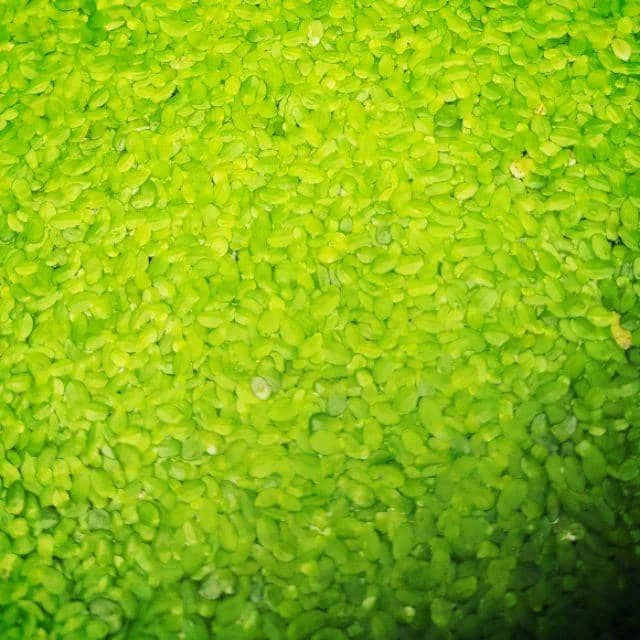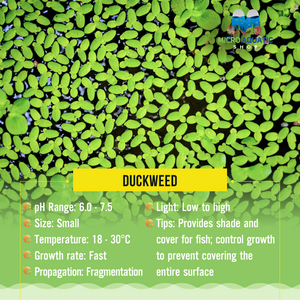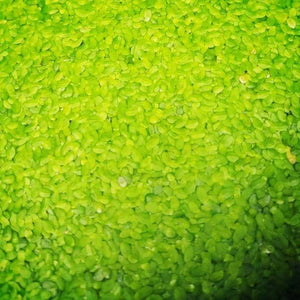Duckweed
Guarantee Safe Checkout
Duckweed - Floating Freshwater Plant for Aquariums: Complete Guide
In Australia, aquarium lovers are always searching for easy-to-care-for plants. Today, we're diving into Duckweed, a floating plant that adds natural beauty to aquariums. This guide will cover everything about Duckweed, from its natural home to its benefits in our aquariums.  Duckweed, or water lentils, is a tiny but mighty plant for freshwater. It may be small, but it's big in helping balance and beautify aquariums. Let's explore how to add Duckweed to your aquarium.
Duckweed, or water lentils, is a tiny but mighty plant for freshwater. It may be small, but it's big in helping balance and beautify aquariums. Let's explore how to add Duckweed to your aquarium.
Key Takeaways
- Duckweed is a versatile floating aquatic plant that can thrive in home aquariums.
- Understanding the natural habitat and growth patterns of Duckweed is crucial for successful cultivation.
- Duckweed offers numerous benefits for aquarium ecosystems, including water purification and nutrient cycling.
- Proper care and maintenance, such as managing light, temperature, and nutrients, are essential for maintaining a healthy Duckweed population.
- Duckweed can be a sustainable resource, with potential applications in bioremediation and animal feed.
Understanding Duckweed and Its Natural Habitat
Duckweed is a floating plant that grows in many places around the world. It's small but very strong. Let's learn about where it grows best and how it thrives.
Native Distribution and Growth Patterns
Duckweed lives in warm and tropical areas globally. In Australia, we see many types, like Lemna minor, Spirodela polyrhiza, and Wolffia arrhiza. These plants spread fast, covering water with a green layer.
Environmental Requirements for Optimal Growth
Duckweed loves rich water, showing us how clean the water is. It grows well in shallow, calm water like ponds and lakes. It needs the right temperature, sunlight, and nutrients like nitrogen and phosphorus.
Common Species Found in Australian Waters
Australia's waters are home to many Duckweed types. Some common ones are:
- Lemna minor (Common Duckweed): A small, free-floating plant with a single root and rounded leaves.
- Spirodela polyrhiza (Greater Duckweed): A larger species with multiple roots and distinctively lobed leaves.
- Wolffia arrhiza (Rootless Duckweed): The smallest known flowering plant, appearing as tiny green dots on the water's surface.
These Duckweeds, and others, play a big role in Australia's water ecosystems. They help keep the balance in nature.
Benefits of Duckweed in Aquarium Ecosystems
Duckweed can greatly improve your aquarium. It's a top plant for cleaning the water by removing extra nutrients. This keeps the water clear and healthy for your fish and other sea creatures. Duckweed is also a natural biofuel. It grows fast and can be turned into energy. This is great for those who want to be kinder to the planet.
- Effective water purification through nutrient absorption
- Provides nutritious food source for fish and other aquatic life
- Aids in maintaining stable pH levels and oxygen balance
- Offers shade and cover for shy or juvenile aquarium inhabitants
- Potential for biofuel production from harvested Duckweed biomass
| Benefit | Description |
| Water Purification | Duckweed's rapid growth and efficient nutrient uptake make it an excellent phytoremediation plant, removing excess nitrates, phosphates, and other pollutants from the aquarium water. |
| Aquatic Food Source | Many fish, shrimp, and other aquatic creatures readily consume Duckweed, providing a nutritious and sustainable food source within the ecosystem. |
| Oxygenation | As a photosynthetic plant, Duckweed releases oxygen into the water, helping to maintain optimal dissolved oxygen levels for aquatic life. |
| Biofuel Potential | The high protein and carbohydrate content of Duckweed makes it a promising feedstock for the production of biofuels, contributing to the sustainability of aquarium keeping. |
Using Duckweed in your aquarium can make it a better place for your fish and help the planet. This amazing plant can make your aquarium a thriving, green space. Let Duckweed help your aquarium flourish.
Proper Care and Maintenance Tips
To keep your Duckweed thriving, balance light, temperature, and nutrients well. These tips will help you maintain a healthy aquarium. This way, you can enjoy the beauty and benefits of Duckweed.
Light and Temperature Requirements
Duckweed likes moderate light, needing 6-8 hours of direct sunlight or a mix of natural and artificial light. Don't let it get too much direct sunlight, as it can grow too fast. Keep the water temperature between 20-30°C. This range suits Duckweed well.
Nutrient Management
Duckweed is great at absorbing nutrients, making it perfect for aquariums. Make sure it gets the right amount of nitrogen, phosphorus, and potassium. But, don't overdo it. Too much fertilizer can cause algae and upset the aquarium's balance.
Controlling Growth and Spread
- Take out extra Duckweed to keep it at a good level on the water's surface.
- Trim or thin the Duckweed when it gets too thick to stop it from taking over.
- Watch how fast it grows and adjust light, nutrients, and water flow to control it.
By following these tips, you can have a healthy, sustainable Duckweed aquarium. It will improve your aquarium's health and balance.
Duckweed as a Sustainable Resource
Duckweed is more than just a plant for aquariums. It's a versatile and sustainable resource for many industries and environmental projects. This floating plant has shown great potential.  Duckweed is great for cleaning wastewater. It absorbs nutrients like nitrogen and phosphorus well. This makes the water clean and safe. Plus, the Duckweed can be used as feed for animals or as a protein source. Duckweed can even be used to make biofuel. Its fast growth and starch content make it a good choice for renewable energy. This supports the move towards cleaner energy sources.
Duckweed is great for cleaning wastewater. It absorbs nutrients like nitrogen and phosphorus well. This makes the water clean and safe. Plus, the Duckweed can be used as feed for animals or as a protein source. Duckweed can even be used to make biofuel. Its fast growth and starch content make it a good choice for renewable energy. This supports the move towards cleaner energy sources.
| Application | Benefits |
| Wastewater Treatment | Nutrient removal, water purification |
| Livestock Feed | Protein-rich, cost-effective |
| Biofuel Production | Renewable energy, sustainable |
Duckweed is a key to a sustainable future. It's used in wastewater treatment and biofuel production. Duckweed is proving to be a valuable resource for a greener tomorrow.
Potential Challenges and Solutions
Duckweed can be a great addition to your aquarium. But, it's important to know the challenges it might bring. Managing it well and acting fast is key to keeping your aquarium healthy.
Managing Overgrowth Issues
Duckweed grows fast. If not controlled, it can cover your aquarium's surface. This blocks light and oxygen for other plants and fish. To stop this, remove extra Duckweed regularly. You can use a net or siphon for this. Also, make sure your aquarium has the right nutrients and water flow. This helps keep Duckweed from taking over.
Common Pests and Diseases
Duckweed can get pests and diseases like algae, bacteria, and snails. Keeping your water clean and watching for problems is crucial. This way, your Duckweed stays healthy and grows well.
Troubleshooting Growth Problems
If your Duckweed isn't growing or looks sick, find out why. Poor light, water changes, or nutrient imbalances can cause problems. Observe your Duckweed closely and adjust its environment as needed. Success with Duckweed in your aquarium comes from being proactive and watching closely. By tackling challenges early, your Duckweed will add beauty and life to your aquarium.
Conclusion
Duckweed is an amazing aquatic plant that offers many benefits for your aquarium. It's great at absorbing nutrients and can be a food source. It's a treasure for anyone who loves aquariums.  Knowing how Duckweed grows and what it needs helps us add it to our aquariums. It makes a great home for our fish and helps keep the water clean. It's perfect for both new and experienced aquarium owners. The importance of sustainable agriculture and caring for our environment is growing. Aquatic plants like Duckweed play a big role in this. By using Duckweed in our aquariums, we can enjoy a beautiful underwater world. We also help protect our environment. Let's keep learning about Duckweed and how it can help our aquariums and the planet.
Knowing how Duckweed grows and what it needs helps us add it to our aquariums. It makes a great home for our fish and helps keep the water clean. It's perfect for both new and experienced aquarium owners. The importance of sustainable agriculture and caring for our environment is growing. Aquatic plants like Duckweed play a big role in this. By using Duckweed in our aquariums, we can enjoy a beautiful underwater world. We also help protect our environment. Let's keep learning about Duckweed and how it can help our aquariums and the planet.
FAQ
What is Duckweed, and where does it naturally grow?
Duckweed is a small, floating plant found in freshwater around the world. It grows well in ponds, lakes, and slow streams. Knowing how it grows helps us care for it in aquariums.
What are the benefits of having Duckweed in my aquarium?
Duckweed is great for aquariums. It cleans the water by taking in extra nutrients. It also provides shade and homes for fish and other creatures. Plus, it's food for some fish, making the aquarium healthier.
How do I properly care for and maintain Duckweed in my aquarium?
To care for Duckweed, focus on light, temperature, and nutrients. We'll show you how to create the best conditions for it. We'll also share tips on keeping its growth in check for a balanced aquarium.
Can Duckweed be used for anything beyond aquariums?
Yes! Duckweed is useful in many ways. It can clean wastewater, be used as biofuel, and even as a protein source. We'll look at its wider environmental benefits.
What are some common challenges with Duckweed in aquariums, and how can I address them?
Duckweed is mostly easy to care for, but some issues can arise. These include managing too much growth, dealing with pests and diseases, and solving growth problems. We'll offer practical advice to keep your Duckweed healthy.
| Size |
A handful 10x10cm, 10 handful ( 1 bag ) |
|---|





